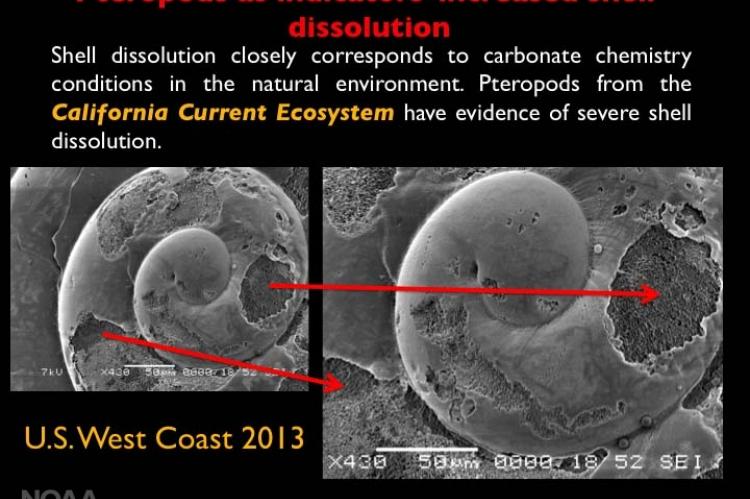Dissolved shells of sea snails linked to human-caused carbon dioxide off US Pacific coast
For the first time, researchers have connected the concentration of human-caused carbon dioxide in waters off the US Pacific coast to the dissolving of shells of marine sea snails called pteropods.
Since the start of the Industrial Era, our oceans have absorbed a third of human-caused CO2 emissions. As a result, the seawater has become more acidic, and this in turn reduces carbonate ions, which are used by shellfish to grow their shells.
Now, researchers from NOAA and partner scientists have determined the percentage of human-caused carbon dioxide from the naturally occurring carbon dioxide along the western coast of the US, linking it directly to the dissolution of pteropod shells.
Found in the Pacific Ocean, the pteropod is a sea snail that is as small as the head of a pin. Its shell is affected by the amount of carbon dioxide in the seawater, and may be an indicator of ocean acidification affecting the larger marine ecosystem.
“Our research shows that humans are increasing the acidification of US West Coast coastal waters, making it more difficult for marine species to build strong shells,” said Richard Feely, a NOAA senior scientist.
A key piece of the new research was determining how much human CO2 emissions have added to naturally occurring CO2 in seawater off the U.S. West Coast. Using data from the Pacific Ocean taken through the U.S. Global Ocean Carbon and Repeat Hydrography Programoffsite link as well as four NOAA West Coast research cruises between 2007 and 2013, the researchers developed a method to estimate additional CO2 from human-caused emissions since the start of the Industrial Era as compared to CO2 from natural sources.
The analysis shows that concentrations of human-caused CO2 are greatest in shallow waters where the atmosphere gives up large amounts of its CO2 to the sea. The researchers estimated that CO2 concentrations from fossil fuel emissions make up as much as 60 percent of the CO2 that enriches most West Coast nearshore surface waters. But the concentrations dropped to 21 percent in deeper waters of 328 feet or 100 metres, and falls even lower to about 18 percent in waters below 656 feet or 200 meters. Concentrations vary depending on location and seasons as well.
The researchers discovered that more than 50 percent of pteropod shells from coastal waters with the high CO2 concentrations were severely dissolved. An estimated 10 to 35 percent of pteropods taken from offshore waters also showed shell damage when examined under a scanning electron microscope.
“We estimate that since pre-industrial times, pteropod shell dissolution has increased 20 to 25 percent on average in waters along the US West Coast,” said Nina Bednaršek of the University of Washington.
“This new research suggests we need a better understanding of how changes in pteropods may be affecting other species in the food chain, especially commercially valuable species such as salmon, sablefish and rock sole that feed on pteropods,” she added.


